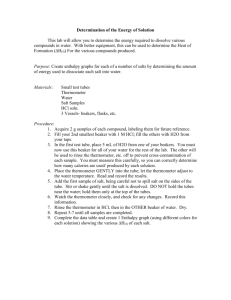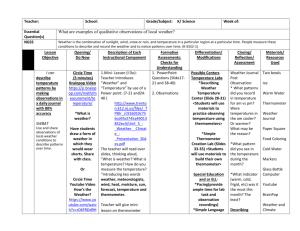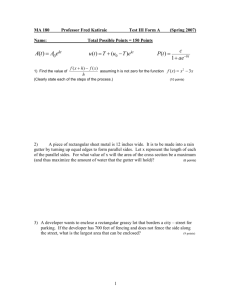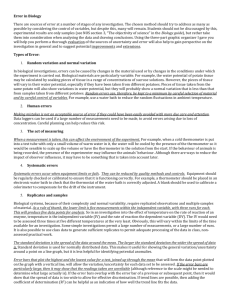Roberta, - MATCOnline
advertisement
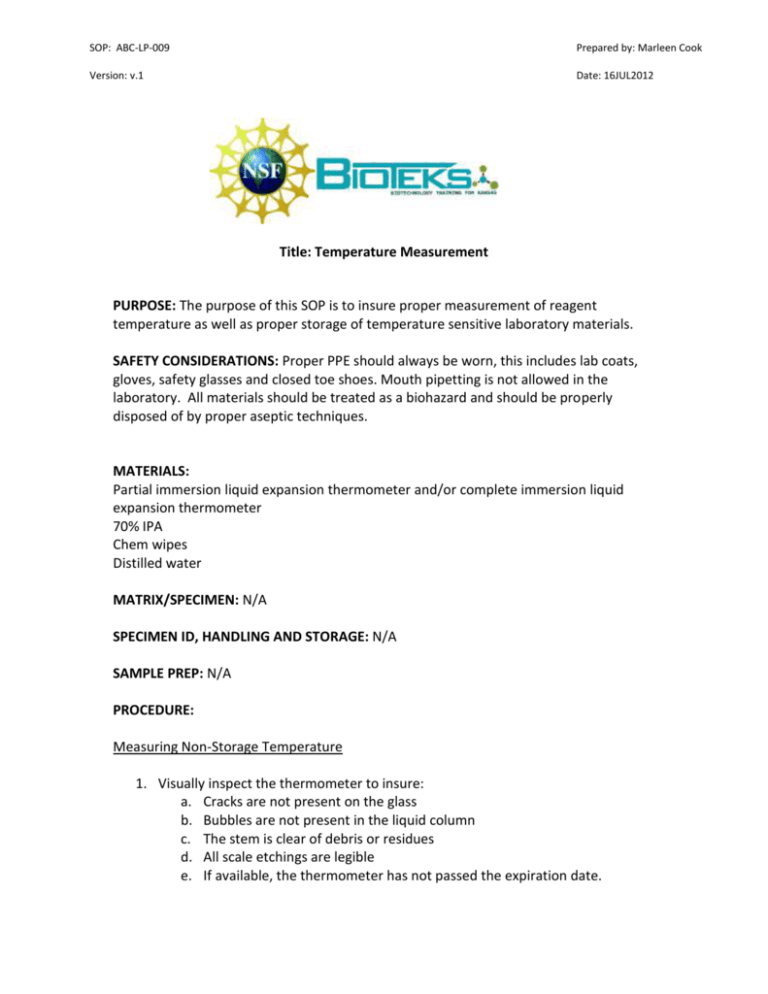
SOP: ABC-LP-009 Prepared by: Marleen Cook Version: v.1 Date: 16JUL2012 Title: Temperature Measurement PURPOSE: The purpose of this SOP is to insure proper measurement of reagent temperature as well as proper storage of temperature sensitive laboratory materials. SAFETY CONSIDERATIONS: Proper PPE should always be worn, this includes lab coats, gloves, safety glasses and closed toe shoes. Mouth pipetting is not allowed in the laboratory. All materials should be treated as a biohazard and should be properly disposed of by proper aseptic techniques. MATERIALS: Partial immersion liquid expansion thermometer and/or complete immersion liquid expansion thermometer 70% IPA Chem wipes Distilled water MATRIX/SPECIMEN: N/A SPECIMEN ID, HANDLING AND STORAGE: N/A SAMPLE PREP: N/A PROCEDURE: Measuring Non-Storage Temperature 1. Visually inspect the thermometer to insure: a. Cracks are not present on the glass b. Bubbles are not present in the liquid column c. The stem is clear of debris or residues d. All scale etchings are legible e. If available, the thermometer has not passed the expiration date. 2. If the thermometer stem contains debris or residues rinse the stem with 70% IPA and wipe with a chem wipe. Prior to submerging the thermometer tips in any reagents or equipment rinse the thermometer with distilled water. If this does not remove the debris and/or if the thermometer possesses any of the malfunctions stated in step 1 consult the instructor for further action. 3. Avoiding tapping the glass thermometer against a hard surface introduce the thermometer slowly into the solution or equipment where temperature is desired. a. If it is a partial immersion thermometer, immerse the thermometer to the depth indicated by the manufacturer. b. Complete immersion thermometers are to be immersed slowly and avoiding rapid temperature change. 4. Read the meniscus with your eyes while the thermometer is positioned at an even level. a. Mercury thermometers is read by the top of the meniscus. b. Organic thermometer is read by the bottom of the meniscus. 5. If the desired temperature has not been reached adjusted the temperature as needed. Remove the thermometer while introducing new temperature elements and re-read the temperature. 6. Record the temperature with three significant numbers. Be sure to include units such as °C, °F and K. If a conversion is necessary for experimental purposes then all work is to be shown. a. Fahrenheit to Celsius i. °C=(°F-32°)0.556 b. Celsius to Fahrenheit i. °F=(°Cx1.8)=32° c. Celsius to kelvin i. °C=K-273 d. Kelvin to Celsius i. kelvin= °C+273 e. Fahrenheit to kelvin i. °C=(x °F-32°)0.556 = y°C ii. kelving= y°C +273 7. When done, rinse the thermometer with 70% IPA wipe down with a chem wipe and rinse with distilled water. 8. Store as indicated by the manufacturer or equipment SOP. Storage of Temperature Sensitive Items 1. Insure the specific temperature storage device is working properly and has been calibrated or checked within the past thirty (30) days. Check the thermometer expiration date. 2. Certain temperature storage unit requires that samples, reagents and/or specimen be stored in a specific container(s). Refer to the specific equipment SOP for instruction. 3. Prior to introducing the sample, reagent and/or specimen to the storage unit insure that it is labeled properly both in individual containers as well as secondary containers for safety and easy accessibility. 4. Refer to the in storage thermometer for proper temperature check. Document the temperature as well as the thermometer ID if available. 5. All samples, reagents and or specimen are to be stored in the upright position and should be positioned completely on a shelf. Boxes are not to be stored higher than two stacks unless a stacker is available. 6. Any spills within or around the storage unit are to be cleaned up prior to closing the unit. ACCEPTANCE FOR RESULTS: Proper storage of temperature sensitive items. ANALYSIS AND INTERPRETATION OF DATA: N/A REFERENCES: N/A



